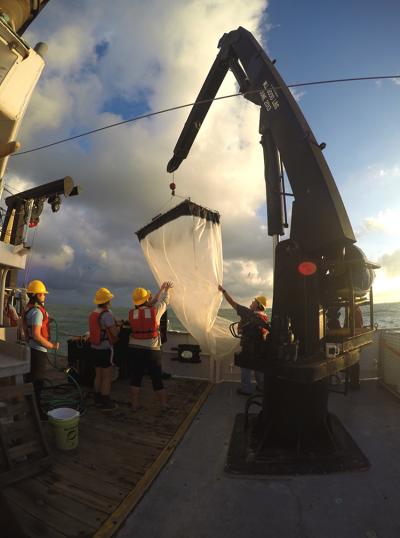USM-led CONCORDE Completes Successful Large-Scale Fall Research Campaign
Tue, 12/01/2015 - 04:49pm

CONCORDE, a GoMRI-funded scientific consortium based out of The University of Southern Mississippi, recently completed a large-scale research mission that was actually five efforts rolled into one.
Chosen to coincide with autumn's low river discharge period, the Fall Campaign included scientists and students from six universities and two government labs, two state-of-the-art research vessels, a scientist sampling from smaller boats, another manning a gliding underwater robot from land, and commercial fishermen collecting data as they went about their routine at sea.
The various teams spent over a week in late October and early November collecting data along transects in the northern Gulf of Mexico from the Chandeleur Islands to the west and the Alabama-Florida border to the east. They simultaneously studied ocean models and satellite data to make sure the scientists continued to find features of interest for the project, such as river plumes.
The goal was to collect data to determine how freshwater outflow from rivers moves through and mixes with the salty water in the northern Gulf when the rivers are traditionally at their lowest volume. This exercise, coupled with a similar campaign in the spring when river stages tend to be highest, will help scientists understand how the interaction with incoming freshwater in the nearshore impacts microscopic marine life such as plankton, and how it could potentially guide the movement of oil or another pollutant in a future catastrophic event.
“Despite a number of challenges that arose during the cruise it was a success,” said R/V Pelican chief scientist Dr. Stephan Howden. “Data were collected that, among other things, will help answer the question about under what conditions will surface flow through the barrier island passes be into the Mississippi Sound, which can bring in surface oil, even though mean flow is out of the Sound.”
A number of moving parts made up this carefully orchestrated campaign. The R/V Point Sur embarked the last week in October from Gulfport with a rotating crew of 18 scientists and students to study plankton populations. Shortly thereafter, the R/V Pelican left from Louisiana so nearly a dozen researchers could focus on the water's physical and bio-optical interactions near the mouth of the Mississippi River.
Both ships had cutting-edge sampling equipment on board as well as good, old-fashioned collection devices like plankton nets to cover all their bases. As USM scientists focus on teaching as much as research, many students got their first taste of field work during the expedition.
A number of smaller, but no less important, efforts supported the larger vessels, as scientists from around the country converged on the Gulf for answers. One researcher from Dauphin Island Sea Lab sampled in and around Mobile Bay from smaller boats using surface drifters to track currents in the area. Another from Rutgers University released an automated glider he manned remotely to sample along the same transects as the larger ships. Even commercial fishermen in Mississippi and Louisiana supported the effort by collecting water samples as they trawled.
“Everyone did a fantastic job,” said R/V Point Sur chief scientist Dr. Frank Hernandez. “We collected an unprecedented amount of biological and oceanographic data for this region. Now the challenging but exciting part for us is to start processing these data and do our best to understand how this system works so that we are better prepared for future events like Deepwater Horizon.”
The institutions involved in the Fall Campaign were as follows: University of Southern Mississippi, University of South Alabama/Dauphin Island Sea Lab, Mississippi State University, Old Dominion University, Oregon State University, Rutgers University, the Naval Research Lab and NOAA.
For more information about this and future CONCORDE research efforts, contact Dr. Jessica Kastler at (228)-872-4269.